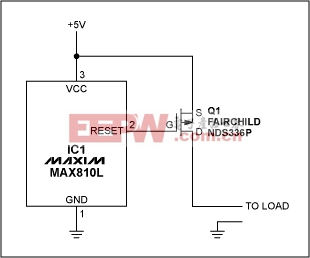复位电路确保有效的电源电压-Reset Circuit En
时间:04-14
来源:互联网
点击:
It is often necessary to prevent a power supply's voltage from being applied to a load until the voltage has reached a certain minimum value. The circuit of Figure 1, consisting of two compact SOT23 packages, protects the load by blocking the supply voltage (nominally 5V) when it is below a pre-set threshold. IC1's threshold is 4.63V; four other versions of this IC provide thresholds of 4.38V, 3.08V, 2.93V, and 2.63V.

Figure 1. This protection circuit applies power to the load only when VCC is above a pre-set threshold voltage.
IC1's active-high Reset output holds the p-channel MOSFET off by remaining high during power-up. It continues to remain high through the end of the reset timeout period (140ms minimum), which is initiated by IC1 as VCC passes through the 4.63V threshold. If VCC remains above 4.63V after the timeout has expired, Reset goes low, turns on Q1, and applies VCC to the load. Q1's on-resistance (0.2Ω for VGS = 4.5V) can deliver 1A of supply current with a drop of only 200mV.
If VCC falters and drops below the threshold during the timeout, or if VCC dips below threshold during normal operation, Q1 turns off and removes VCC from the load. During power-down as well, Reset goes high and turns Q1 off as soon as VCC drops below the threshold. IC1 maintains this gate drive for VCC down to 1V; below that level, the load remains safe because VGS is too low to turn Q1 back on.
This circuit can be implemented with any microprocessor-reset device offering an active-high, push-pull reset output. As alternatives offering other threshold levels and feature combinations, consider the MAX812, MAX824, MAX6327, and MAX6332.

Figure 1. This protection circuit applies power to the load only when VCC is above a pre-set threshold voltage.
IC1's active-high Reset output holds the p-channel MOSFET off by remaining high during power-up. It continues to remain high through the end of the reset timeout period (140ms minimum), which is initiated by IC1 as VCC passes through the 4.63V threshold. If VCC remains above 4.63V after the timeout has expired, Reset goes low, turns on Q1, and applies VCC to the load. Q1's on-resistance (0.2Ω for VGS = 4.5V) can deliver 1A of supply current with a drop of only 200mV.
If VCC falters and drops below the threshold during the timeout, or if VCC dips below threshold during normal operation, Q1 turns off and removes VCC from the load. During power-down as well, Reset goes high and turns Q1 off as soon as VCC drops below the threshold. IC1 maintains this gate drive for VCC down to 1V; below that level, the load remains safe because VGS is too low to turn Q1 back on.
This circuit can be implemented with any microprocessor-reset device offering an active-high, push-pull reset output. As alternatives offering other threshold levels and feature combinations, consider the MAX812, MAX824, MAX6327, and MAX6332.
模拟电源 电源管理 模拟器件 模拟电子 模拟 模拟电路 模拟芯片 德州仪器 放大器 ADI 相关文章:
- 采用数字电源还是模拟电源?(01-17)
- 模拟电源管理与数字电源管理(02-05)
- 数字电源正在超越模拟电源(03-19)
- 数字电源PK模拟电源(04-03)
- TI工程师现身说法:采用数字电源还是模拟电源?(10-10)
- 开关电源与模拟电源的分别(05-08)
